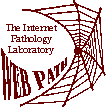Clinical History:
- This 81-year-old man was in good health until developing a cough with the production of yellow sputum. He complained to his relatives of a headache the day before admission. He was found stuporous by his son on the day of admission. In the emergency room, the physical examination demonstrated an elderly man who was not responding very well to questions. His temperature was 38 C (99.7 F), respirations 16/min, pulse 100/min and weak, and blood pressure 110/50 mm Hg. His neck was stiff. A lumbar puncture revealed cloudy cerebrospinal fluid with a marked pleocytosis with 1500 WBC's (90% of them PMN's), no RBC's, glucose of 31 mg/dL, and protein of 60 mg/dL. His serum glucose was 80 mg/dL.
Further history:
- The patient does not respond to treatment and dies.
Image 2.1:
- This is a gross photograph of his brain. Describe the appearance. What is the pathogenesis of this lesion?
- The brain shows a whitish exudate in the meninges with hyperemia of the vessels over the surface of the brain. This appearance is caused by numerous white blood cells responding to the presence of bacteria and represents frank pus. The vessels are engorged as a response to the infection and the need to bring more inflammatory cells to the area. Although not very evident here, the underlying brain parenchyma becomes edematous in response to the infection.
Image 2.2:
- This is a microscopic photograph with H&E staining of the subarachnoid space. Describe the microscopic findings.
- The subarachnoid space is filled with polymorphonuclear leukocytes and the vessels are engorged with blood.
Answers:
- What is the diagnosis? What is the most likely organism in this man?
Acute meningitis is the diagnosis. The CSF findings with the elevated WBC count consisting of mostly neutrophils, the decreased glucose, and the elevated protein are characteristic for a bacterial meningitis. In most cases the gram stain of the CSF will reveal organisms. Culture of the CSF offers a definitive diagnosis. Serologic assays can be done for the most common etiologic agents, such as S. pneumoniae, N. meningitidis, E. coli, H. influenzae, type b, and group B streptococcus. At his age the most common cause is Streptococcus pneumoniae.
- What would be your treatment?
Immediate institution of intravenous penicillin G. Persons allergic to penicillin can be given chloramphenicol or vancomycin.
- What is a possible cause of death in this man?
Uncal and tonsillar herniation with brainstem compression can occur because of brain edema.
|
|



